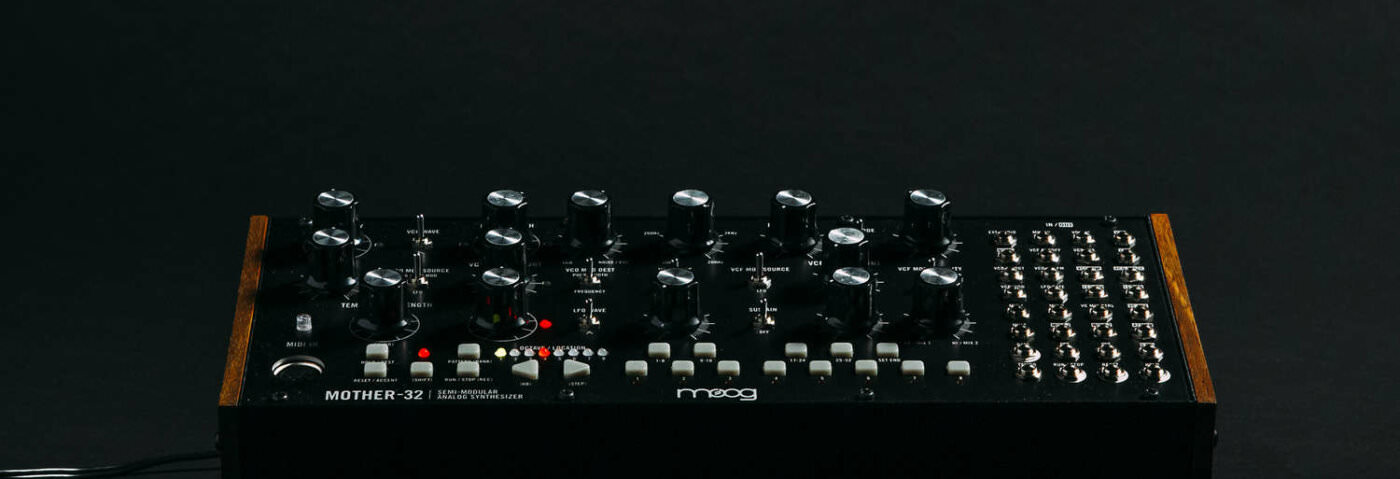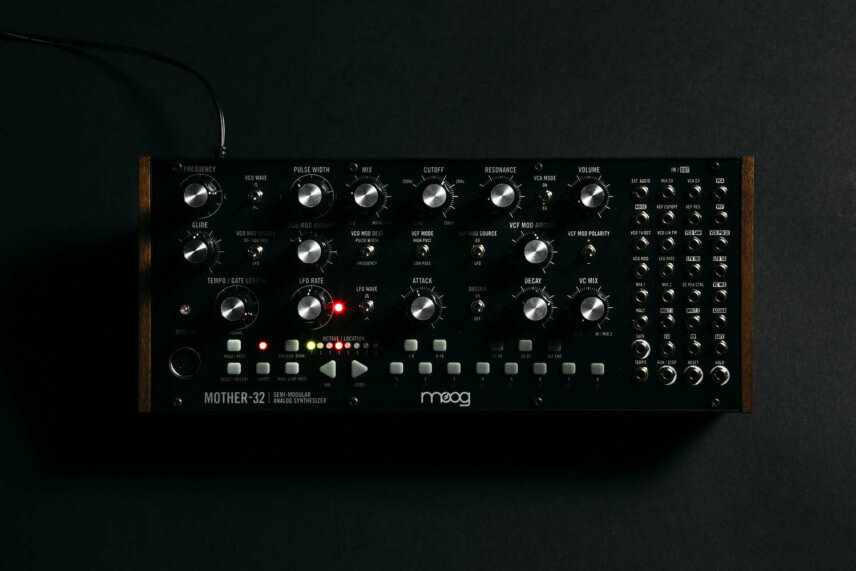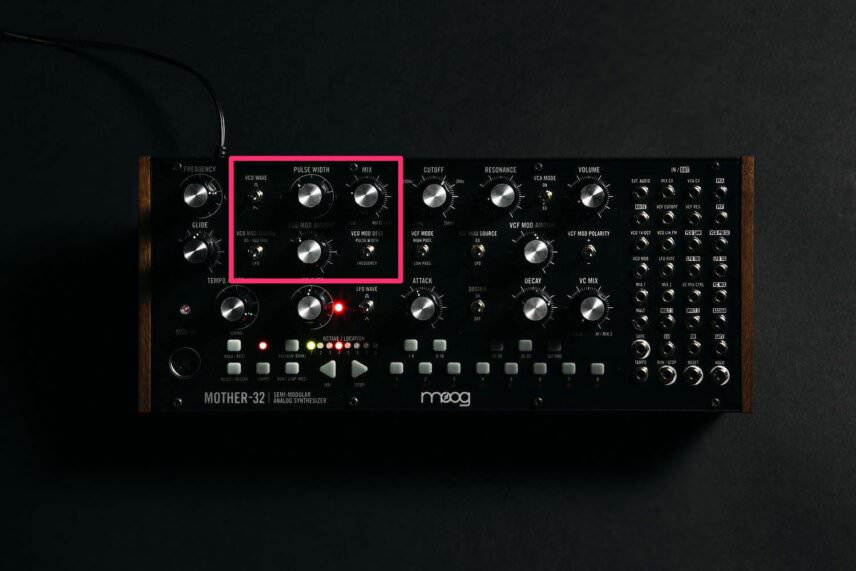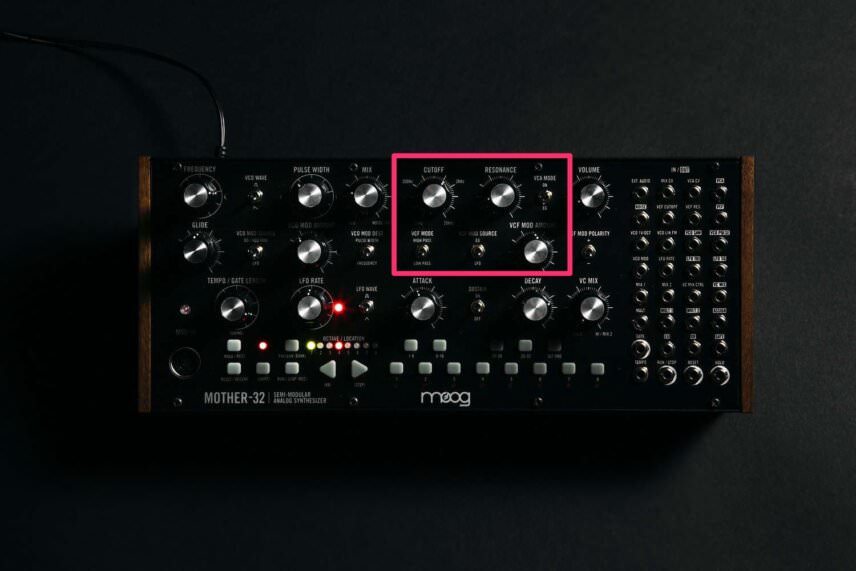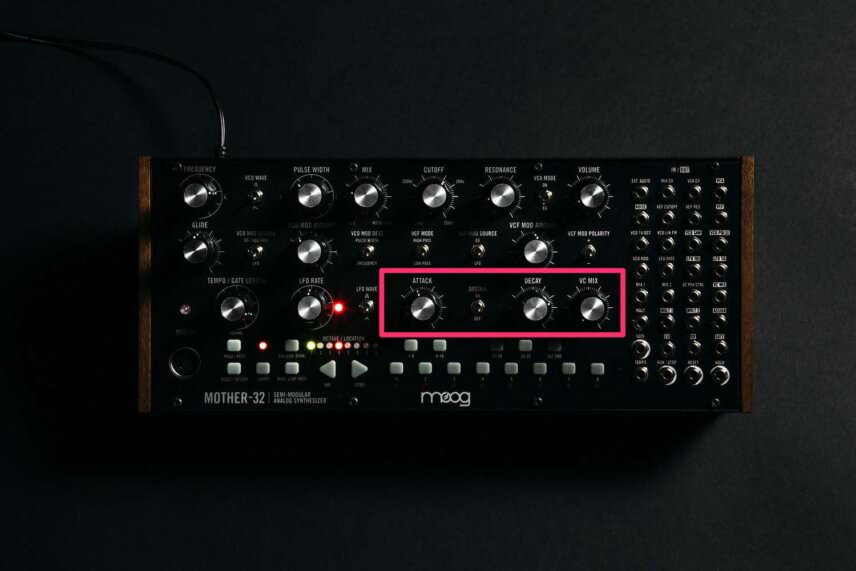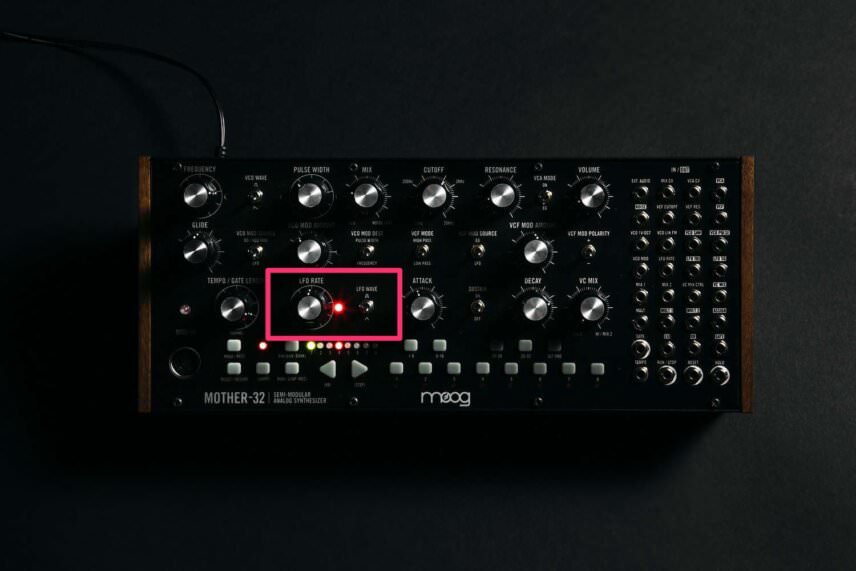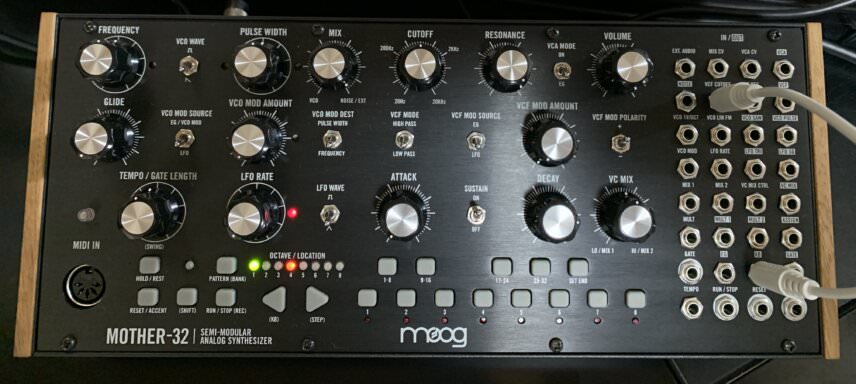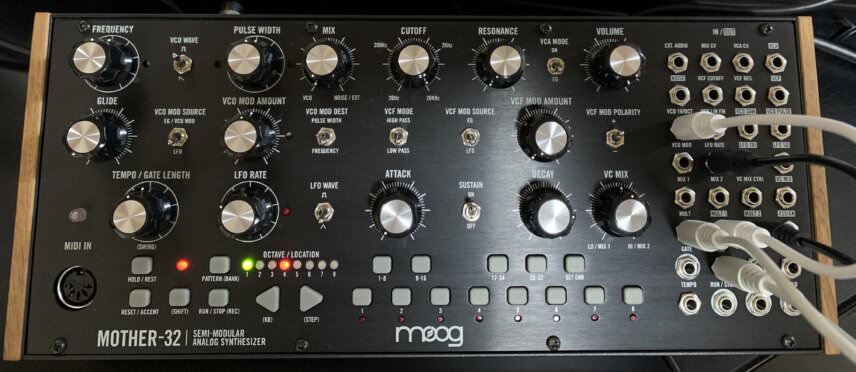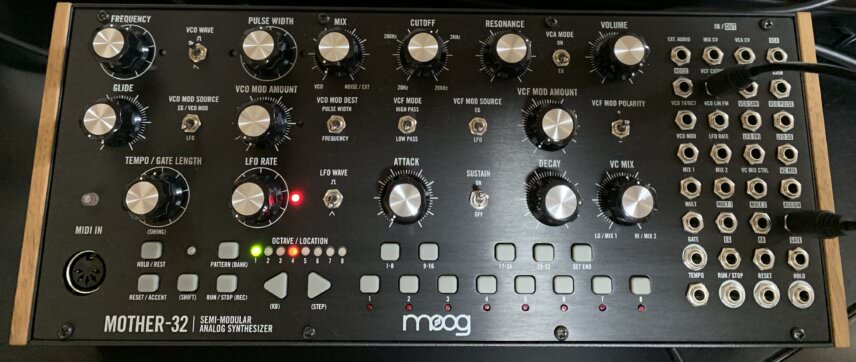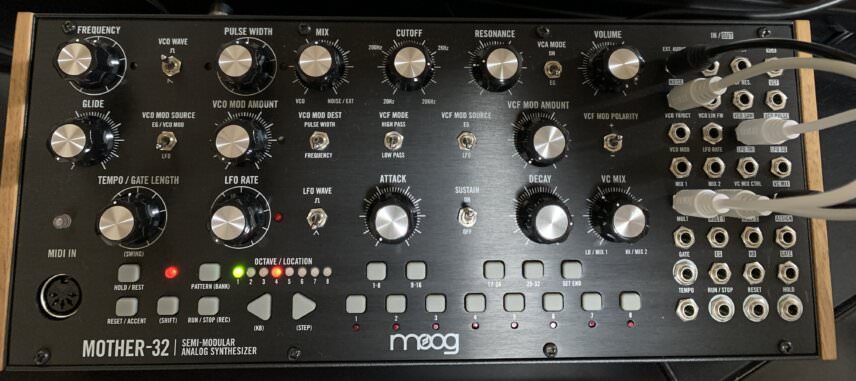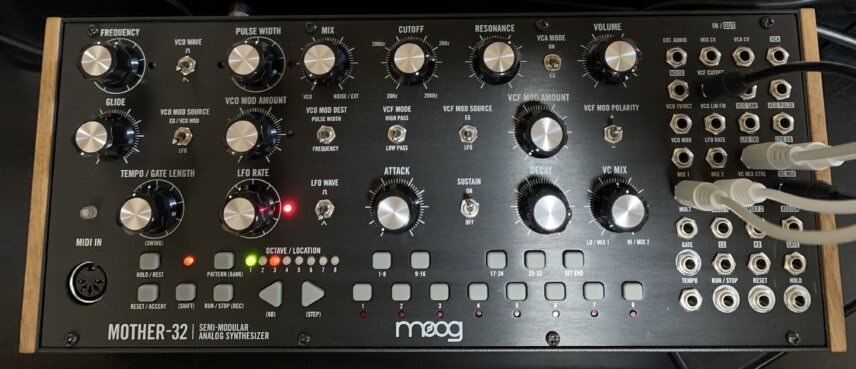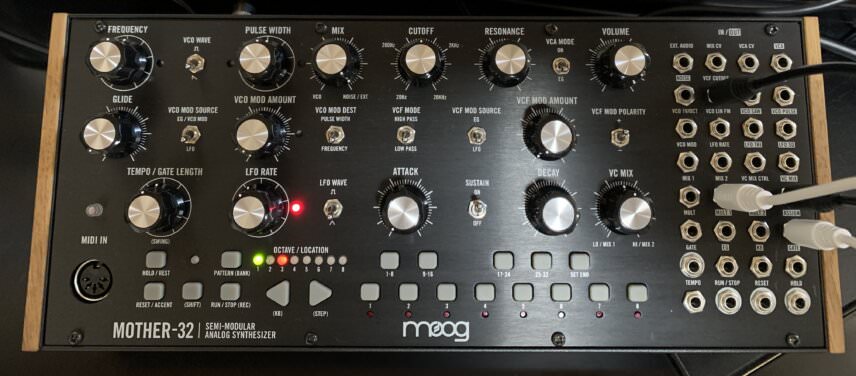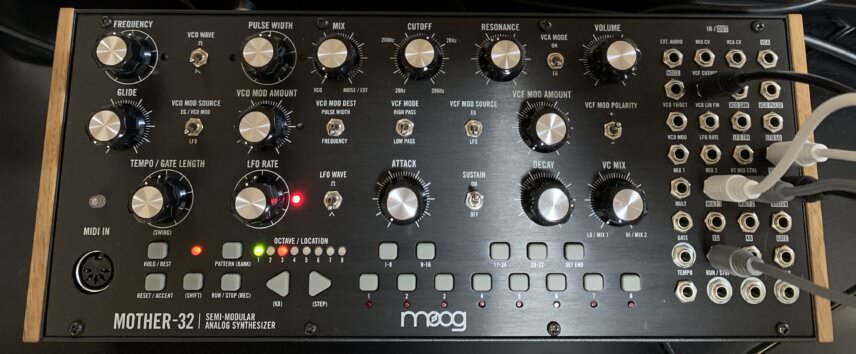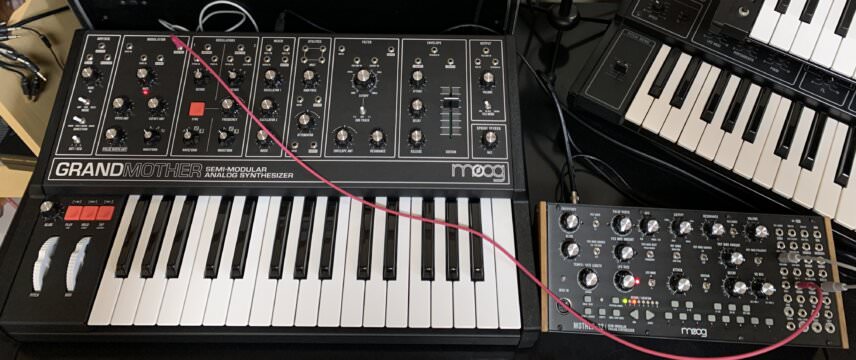Confused about subtractive synthesis? We use the Moog Mother-32 to explain oscillators, filters, and envelopes, plus take things to the next level with the patchbay.
For the beginner, analogue subtractive synthesis can be a little overwhelming. All those knobs and sliders, and the arcane terminology! Even if you have a general idea of how things work, getting the sound you have in your head can be a laborious task of largely trial and error. With the newbie in mind, we’ve put together this short guide to analogue subtractive synthesis.
Before we get into it though, we should define what analogue subtractive synthesis is. Subtractive synthesis was developed by Bob Moog in the 1960s. The idea is that you start with a harmonically rich sound source (the oscillators) and then subtract from it using filters and volume. It’s sort of like a sculptor starting with a big slab of marble and then removing stone along the way.
A Quick Overview of the Mother-32
Moog’s Mother-32 is a monophonic analogue synthesizer module. It can be used standalone or removed from its case and inserted into a Eurorack modular system. Along with the usual subtractive synthesis parameters (which we’ll explore next), The Moog Mother-32 has a sequencer, a built-in single-octave push-button keyboard, and a patchbay. Mother-32 is semi-modular, meaning that it has a basic, prewired signal path and will work as-is but there are additional synthesis functions that can only be accessed via the patchbay. As the name suggests, there are 32 patch points, all placed at the right of the panel.
The Classic Moog Subtractive Voice
As previously mentioned, the sound starts with the oscillator, or VCO (voltage controlled oscillator). This plays notes as triggered (or ‘controlled’) by the keyboard. A VCO can play a number of different waveforms, such as sawtooth or square (sometimes called pulse), as on the Moog Mother-32.
A sawtooth wave:
A pulse wave:
A filter or VCF (voltage controlled filter) is something like an equalizer for shaping the tone of the oscillator output. Unlike a regular EQ, which has multiple bands, a filter can generally only handle one frequency range at a time. The most common is the lowpass filter (it cuts highs, or allows lows to pass through). You may also encounter a highpass filter (cuts lows), or bandpass filter (cuts everything outside the band). Resonance boosts volume at the frequency cutoff point, creating a distinctive squelchy sound.
A sawtooth wave swept with the Mother-32’s lowpass filter with heavy resonance:
The amplifier section of an analogue synthesizer, or VCA (voltage controlled amplifier), dynamically attenuates the audio signal before it reaches the output stage. You can control the VCA with envelopes. Envelopes can affect either audio or control signals, usually over time.
Here are some examples of envelopes:
- ADSR: The classic four-stage envelope, with controls for Attack (how long it takes the sound to reach full volume), Decay (how long it takes for the volume of the signal to decrease after reaching the peak of the Attack), Sustain (controls the held portion of the note), and Release (how long the note is audible after releasing the key).
- ADS: The Mother-32 has an ADS envelope shape, with Sustain being either on or off.
- ASR: In the ASR configuration, there is no Decay portion.
- AD: A simple envelope with only Attack and Decay.
A note shaped by the ADS envelope on the Mother-32:
Envelopes are considered to be modulation sources. Another modulation source is the LFO or low frequency oscillator. As the name implies, this is an oscillator but one that outputs only extremely low frequencies. These are generally inaudible to our ears but they can function as controllers for other parameters. You can use them to create vibrato effects, as well as modulate the filter cutoff, among other things.
The same note with vibrato via the LFO:
Exploring the Patchbay
With the patchbay on the Mother-32, you can greatly expand on the synthesis possibilities above and beyond just the prewired signal path. Let’s take a look at some of them.
Typically, the keyboard (either the onboard keyboard or one plugged in via MIDI) changes the pitch of the oscillator. However, it can also be used to track the pitch of other destinations, such as the filter. By patching from the KB output to the VCF Cutoff in, and cranking up the filter resonance until it self oscillates, we can play the filter like an oscillator. Make sure to turn the Mix knob to Noise to give the filter something clean to work with.
Playing the filter:
A handy function to have when patching a synthesizer is a mult, or mutiple jack. With the Mult section in the Mother-32 patchbay, we can split any incoming signal into two, and then route it to two destinations. In this patch, we have sent the envelope from EG out to the Mult, and then on to both VCO 1 (to control pitch) and LFO Rate (to make the rate change over time).
Using the Mult:
Mother-32 has an assignable output. There are 16 different possible sources to choose from. We have set it to Step Random, which outputs a random voltage per step of the sequencer. By patching this into VCF Cutoff in, and pressing play on the sequencer, we can create a sample and hold effect.
Sample and hold with the assignable jack:
Exploring the VC Mix
One of the unique parameters on the Mother-32 is the VC Mi. This knob can only be accessed through the patchbay. It is represented on the patchbay as Mix 1 and Mix 2 inputs and VC Mix output, with additional voltage control over mix amount. The VC Mix can take either audio or control voltage signals, making it a particularly useful tool. It can be used as an audio crossfader, VC crossfader, attenuator, and VCA.
Let’s use it as a crossfader first to blend between two audio signals. The regular Mix dial on the Mother-32 blends between VCO on one side and either noise or the external audio in on the other. We could use this knob to create a blend of both sawtooth and pulse waves by patching pulse directly from the patchbay to the external in. However, we’d lose noise this way. However, by mixing noise and sawtooth together with VC Mix, and then out from VC Mix to Ext. Audio in, we can play all three sound sources at the same time. We can then use the VC Mix to control the amount of noise present in the signal versus the sawtooth.
A blend of the two waveforms plus noise with manual knob adjustments:
Next, let’s try using VC Mix as a VC crossfader. Although you can only access one LFO wave shape from the front panel at a time, you can use the patchbay to get at both the triangle and square wave shapes. Patch from LFO Tri to Mix 1, and LFO Sq to Mix 2. Go out from VC Mix out to VCF Cutoff in. Now we can control the cutoff of the filter with a mix of the two LFO wave shapes.
Both LFOs blended together with manual VC Mix knob adjustments:
When accessing parameters from the front panel, there is often a knob available to control the amount (or ‘depth’) of the effect. When patching though, you have to use a dedicated attenuator to dampen the amount of control voltage. VC Mix can act as an attenuator for Mother-32. Let’s revisit our sample and hold patch from before. This time, instead of going straight from the Assign output to the filter cutoff, route it into Mix 2 first, and then from VC Mix out to VCF Cutoff in. Now we can use the VC Mix dial to soften the impact of the random voltage on the filter cutoff.
Using the VC Mix as an attenuator starting at full power and then damping down:
Finally, let’s use the VC Mix as a VCA for control voltage and use it to dynamically control the amount of cutoff LFO modulation. First, go out from LFO Sq to the Mix 2 input and turn the VC Mix knob all the way to the left. Next, patch from VC Mix out to VCF Cutoff in. Lastly, we want to use the envelope to modulate the LFO amount, so go out from EG to VC Mix Ctrl in.
Using VC Mix as a VCA:
Incorporating Mother-32 With Other Hardware
One of the advantages of a semi-modular synth is you can connect it to other semi-modular and modular gear. Let’s pair the Mother-32 with Moog’s Grandmother Dark edition to expand the possibilities.
In this patch, we’re using the sinewave LFO on the Grandmother (something the Moog Mother-32 lacks) to affect the pitch of the oscillator while the onboard LFO modulates the filter cutoff. Just patching straight into VCO 1 V/Oct. creates a very intense effect so we use VC Mix to attenuate the Grandmother LFO (see above) first.
Pairing Grandmother and Moog Mother:
